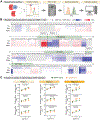Dissecting the molecular basis for the modulation of neurotransmitter GPCR signaling by GINIP
- PMID: 37989308
- PMCID: PMC10872408
- DOI: 10.1016/j.str.2023.10.010
Dissecting the molecular basis for the modulation of neurotransmitter GPCR signaling by GINIP
Abstract
It is well established that G-protein-coupled receptors (GPCRs) stimulated by neurotransmitters are critical for neuromodulation. Much less is known about how heterotrimeric G-protein (Gαβγ) regulation after receptor-mediated activation contributes to neuromodulation. Recent evidence indicates that the neuronal protein GINIP shapes GPCR inhibitory neuromodulation via a unique mechanism of G-protein regulation that controls pain and seizure susceptibility. However, the molecular basis of this mechanism remains ill-defined because the structural determinants of GINIP responsible for binding and regulating G proteins are not known. Here, we combined hydrogen-deuterium exchange mass spectrometry, computational structure predictions, biochemistry, and cell-based biophysical assays to demonstrate an effector-like binding mode of GINIP to Gαi. Specific amino acids of GINIP's PHD domain first loop are essential for G-protein binding and subsequent regulation of Gαi-GTP and Gβγ signaling upon neurotransmitter GPCR stimulation. In summary, these findings shed light onto the molecular basis for a post-receptor mechanism of G-protein regulation that fine-tunes inhibitory neuromodulation.
Keywords: GABA; GAP; GINIP; GPCR; GTPase; KIAA1045; Neuron; Neurotransmitter; PHF24; RGS protein.
Copyright © 2023 Elsevier Ltd. All rights reserved.
Conflict of interest statement
Declaration of interests The authors declare no competing interests.
Figures








Update of
-
Dissecting the molecular basis for the modulation of neurotransmitter GPCR signaling by GINIP.bioRxiv [Preprint]. 2023 Apr 21:2023.04.20.537566. doi: 10.1101/2023.04.20.537566. bioRxiv. 2023. Update in: Structure. 2024 Jan 4;32(1):47-59.e7. doi: 10.1016/j.str.2023.10.010. PMID: 37131787 Free PMC article. Updated. Preprint.
References
MeSH terms
Substances
Grants and funding
LinkOut - more resources
Full Text Sources
Miscellaneous

